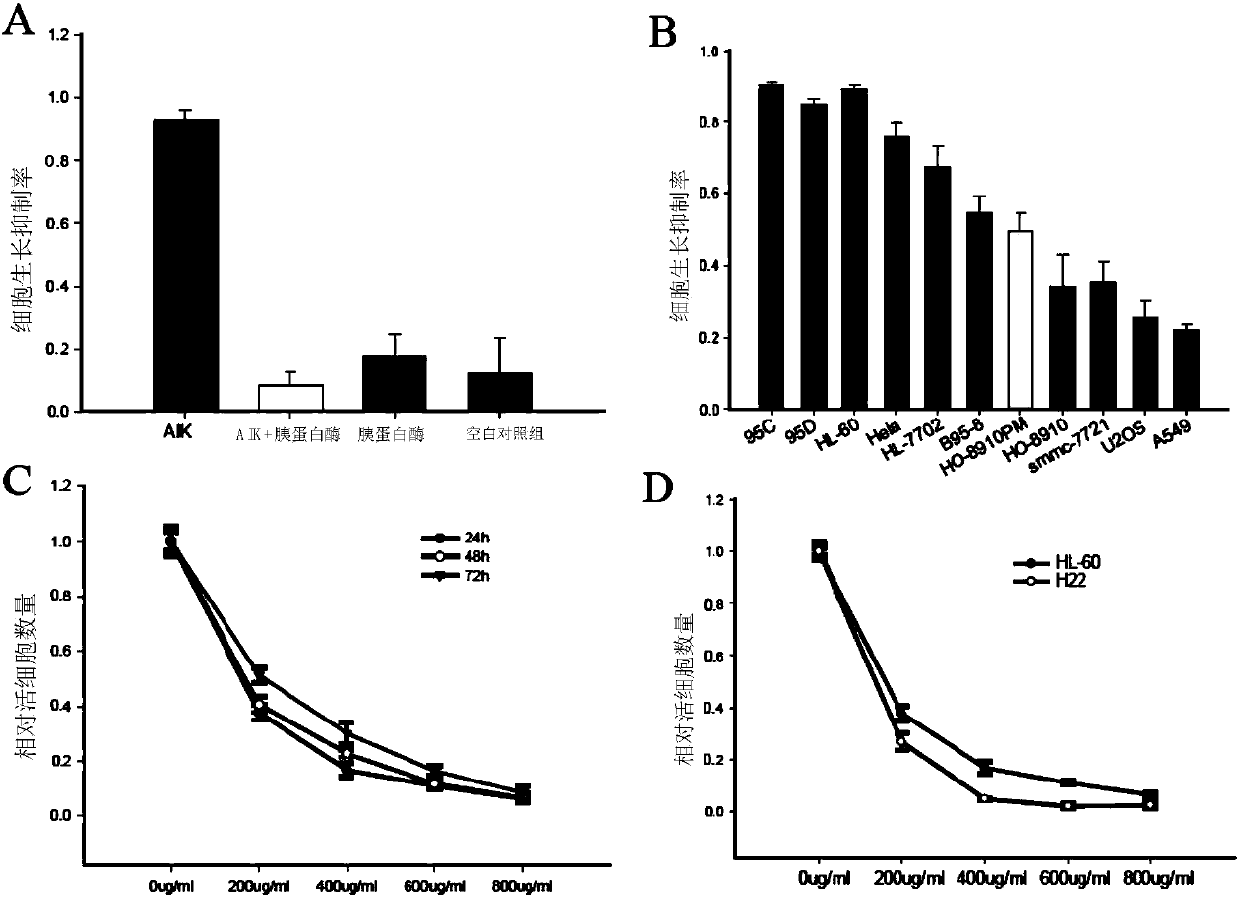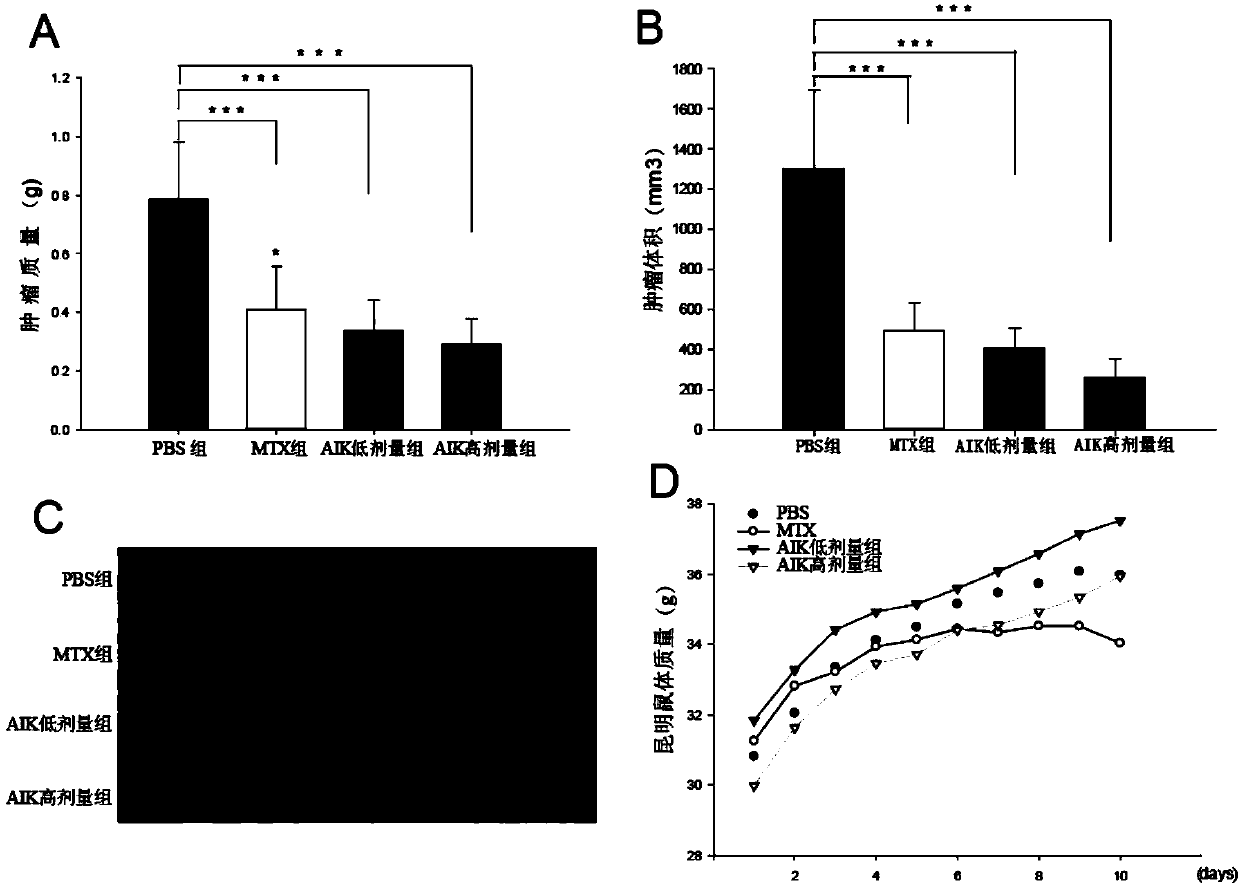Artificially synthesized cationic peptide and applications thereof in preparing anti-tumor drug
An anti-tumor drug, artificial synthesis technology, applied in the biological field, can solve the problems of large molecular weight, poor tissue penetration, low anti-tumor activity, etc., to achieve a small molecular weight, high anti-tumor activity, easy to penetrate tumor tissue Effect
- Summary
- Abstract
- Description
- Claims
- Application Information
AI Technical Summary
Problems solved by technology
Method used
Image
Examples
Embodiment 1
[0027] Embodiment 1 Artificial chemical synthesis method prepares AIK on a large scale
[0028] 1. Chemical synthesis of AIK:
[0029]Synthesized by Beijing Saibaisheng Gene Technology Co., Ltd. Using the ABI433peptide synthesizer full-brake peptide synthesizer from Applied Biosystems, the solid-phase peptide synthesis method was used to continuously add, react, and synthesize from the C-terminus-carboxyl-terminus to the N-terminus-amino-terminus according to the sequence of AIK, and finally synthesized 100mg25 peptide AIK. The amino acid sequence is shown in SEQ ID NO.1, its isoelectric point (pI) is 12.96, and its theoretical molecular weight (MW) is 3456.35Dalton.
[0030] The synthesized polypeptide is purified by reverse liquid phase high-pressure chromatography and identified by protein spectrum, and the purity is higher than 95%.
[0031] 2. Reversed-phase liquid chromatography column (C18) for deep purification of AIK polypeptide:
[0032] (1) Add 2 mL of acetonitri...
Embodiment 2AI
[0039] Embodiment 2 AIK inhibits tumor cell growth activity in vitro
[0040] 1. The cell lines used and their sources:
[0041] Cell lines 95C (low metastatic giant cell carcinoma of the lung), 95D (high metastatic giant cell carcinoma of the lung), HL-60 (acute promyelocytic leukemia), Hela (cervical cancer), HL-7702 (normal liver cells), B95 -8 (Epstein-Barr virus-infected leukemia), HO-8910PM (high metastatic ovarian cell carcinoma), HO-8910 (low metastatic ovarian cell carcinoma), SMMC-7721 (liver cancer cells), U2OS (myeloma cells), A549 (lung Adenocarcinoma cells) and other tumor cell lines were purchased from ATCC cell bank in the United States and stored in liquid nitrogen for a long time. The mouse liver cancer H22 ascites cell line is a cell bank of Harbin Medical University, and is now preserved by intraperitoneal inoculation of Kunming mice. All cells were cultured in DMEM medium (containing 10% FBS, purchased from Invitrogen) at 37°C, 5% CO 2 Incubator subcult...
Embodiment 3AI
[0056] Example 3 AIK inhibits the growth of subcutaneously transplanted tumors in tumor-bearing mice
[0057] 1. Experimental animals: 4-5 weeks old, 20-25g male Kunming mice, provided by the Experimental Animal Center of Harbin Medical University. The operation of animal experiments complied with the relevant rules of animal experiments of Harbin Medical University.
[0058] 2. Establishment of H22-bearing liver cancer cell subcutaneous xenograft mouse model
[0059] The mouse liver cancer H22 cells frozen in liquid nitrogen were quickly thawed in a 37°C water bath, and 3 Kunming mice were inoculated intraperitoneally, 0.5ml / mouse. One H22 ascites tumor model mouse was taken on the 8th day of passage, and sacrificed by cervical dislocation, and 8 ml of milky white ascites in the abdominal cavity of the mouse was sucked aseptically in an ultra-clean bench. 1:10 dilution and counting, PBS adjusted the concentration of tumor cell suspension to 5×10 6 pieces / ml. Disinfect the...
PUM
 Login to View More
Login to View More Abstract
Description
Claims
Application Information
 Login to View More
Login to View More - R&D
- Intellectual Property
- Life Sciences
- Materials
- Tech Scout
- Unparalleled Data Quality
- Higher Quality Content
- 60% Fewer Hallucinations
Browse by: Latest US Patents, China's latest patents, Technical Efficacy Thesaurus, Application Domain, Technology Topic, Popular Technical Reports.
© 2025 PatSnap. All rights reserved.Legal|Privacy policy|Modern Slavery Act Transparency Statement|Sitemap|About US| Contact US: help@patsnap.com



